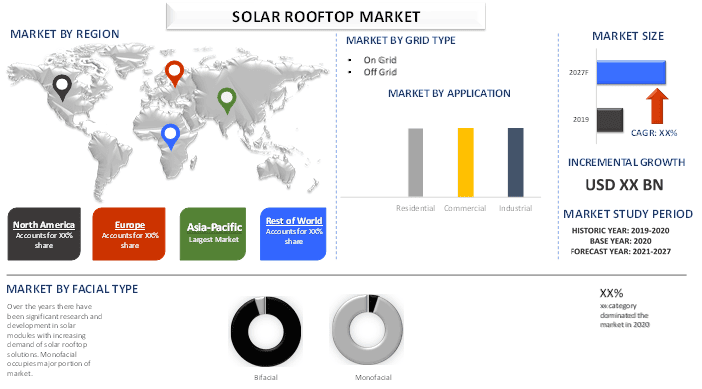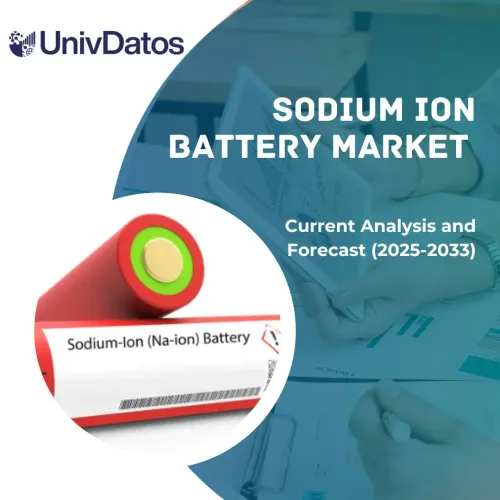- Home
- About Us
- Industry
- Services
- Reading
- Contact Us
Solar Rooftop Panel Market: Current Analysis and Forecast (2021-2027)
Emphasis on Grid Type (On-Grid, Off-Grid); End User (Residential, Commercial, Industrial); Capacity (1KW-10KW, 11KW-100KW, 101KW-1MW, and 1MW and above), Technology (Thin Film, Monocrystalline, Polycrystalline, PERC Monocrystalline); Facial Type (Monofacial and Bifacial) and Region and Country

In 2020, the global solar rooftop market was generated value of around US$66 billion and is likely to demonstrate the healthy CAGR of above 6% during the forecast period (2021-2027). Contemplating the efficiency, cost, and environmental concerns the demand of renewable energy has risen continuously. Owing to fluctuating electricity prices, solar rooftop solutions act as a secure investment and arrive at breakeven point in 2–3 years from the date of installation. Due to lack of grid transmission in sub urban areas specially in parts of Africa and South Asian countries the demand of off grid solar rooftop solutions has increase significantly over the years although, it has high installation cost as compared to on-grid solar rooftop solution. Furthermore, decline in the price of solar modules and subsidies provided by government there has been a shift in the demand thereby giving people power to adopt the usage of rooftop solar modules. Owing to, above factors the demand of solar rooftop solutions is likely to increase at a considerable rate in the forecast period. During the Covid-19 pandemic in the early 2020, majority of the countries and region witnessed a country wide lockdown. This has impacted the overall demand for hydrogen gas. Globally countries witnessed economic slowdown. Majority of decline was witnessed in the industrial sector, where countries had imposed shut down of manufacturing facilities to reduce the spread of Covid-19. However, demand for hydrogen is expected to come to normal post 2020.
Insights Presented in the Report
“Amongst Grid Type, on grid held significant market share in 2020.”
Based on Grid type, solar rooftops are bifurcated into on grid and off grid solar rooftop. Of both, on grid occupies the largest market share owing to low installation and maintain costs, as it does not require batteries to be installed. Hence, cost of batteries and their maintenance is reduced. However, in case of grid failure on grid solar rooftop does not have any backup although with rising development in countries grid transmission is increasing and electricity cuts are decreasing thereby making it more suitable to install. Off grid rooftop uses batteries to store energy thereby increasing installation and maintenance cost. Moreover, in developing countries where grid transmission is less, installing an off grid solar rooftop system can proved to be an asset. According to World Bank, off grid solar rooftop system have played a pivotal role in providing energy access to millions of people, especially in Sub-Saharan African and South Asia.
“Amongst End User, industrial sector held considerable market share in 2020.”
Based on End User, residential, commercial, industrial are the three solar rooftop categories. Between the three categories, currently industrial sector captures a significant market share owing to growing industrialization and cost effectiveness which is result of net metering. With rising environmental concerns among the population residential sector is projected to grow at an influential rate in the forecast period. Off grid solar rooftop solution provides energy storage system which is reliable secondary power especially in residential household, sub-urban and rural areas. Further, commercial sector is likely to grow at an optimum rate owing to substantially growing demand from schools, colleges, hotels, hospitals, and corporate offices.
“Amongst Capacity, 11KW–100KW category held remarkable market share in 2020.”
Based on capacity, the market is categorized into 1KW-10KW, 11KW-100KW, 101KW-1MW, and above 1MW. Among these, 11KW–100KW category captured the significant market share in 2020 and is expected to grow at a substantial rate during the forecast period.
“Amongst Technology, Monocrystalline solar panels held prominent market share in 2020.”
Based on Technology, solar rooftops are divided mainly into four categories namely thin film, monocrystalline, polycrystalline, PERC monocrystalline (Passivated Emitter and Rear Cell). Among four PERC monocrystalline panels are likely to grow at an influential rate in the forecast period owing to high efficiency of 21% to 25% and less rooftop space requirement although the manufacturing cost is more. For Instance, being new technology, its manufacturing cost ranges from 1.80 USD/W to 2.30 USD/W. However, being the most efficient option irrespective of moderate installation cost, currently monocrystalline panel holds the significant market share. In addition, the average cost for installing monocrystalline solar module 10KW plant ranges from $10,000 to $15,000 which is the best investment option for residential, commercial, and industrial sector. Moreover, thin film is less efficient and inexpensive and requires large space therefore it is mainly used by industries. Polycrystalline panels having efficiency of 15% to 17% is middle option solar rooftop solution due to low tolerance of heat resulting in low efficiency compared to monocrystalline panels.
“Amongst Facial Type, Monofacial solar panels held significant market share 2020.”
Based on Facial Type, in 2020, monofacial held the significant market share owing to less maintenance cost and more awareness among the population. However, monofacial panels generates less electricity as compared to bifacial panels and requires more rooftop space. Bifacial solar panels are equipped with transparent back sheet of conductive oxide which allows reflected light to reach the rear of the heterojunction technology cells, producing approximately 30% more electricity than monofacial panels. Despite of high maintenance cost of transparent conductive oxides (TCO) the demand of bifacial solar rooftop solution is expected to increase at an influential rate owing to less rooftop space required and high electricity generation.
“Asia Pacific represents as the largest markets in the Global Solar Rooftop Market.”
For a better understanding of the market adoption, report provide detailed analysis for major region and countries including North America (US, Canada, Rest of North America), Europe (Germany, UK, Russia, France, Spain, Rest of Europe), Asia-Pacific (China, Japan, India, Australia, Rest of APAC), and Rest of World. Owing to significant demand of solar rooftop market from industrial, residential, and commercial sector owing to fluctuating electricity prices. Asia Pacific accounted for the largest market share in 2020 and is expected to continue its dominance over the forecast period. Availability of cheap raw material played a major role for Asia Pacific to hold the largest market share. Government subsidies and supporting government policies regarding clean energy are driving the market grow in the region. Moreover, with increasing population in the region requirement for clean fuel power generation along with people adopting solar rooftop in their residences, residential sector is anticipated to continue its dominance over the forecast period. Further, well developed technology and supporting government policies to promote solar panel use in the country with growing focuses of solar manufacturing companies like JA Solar Holding and Trina Solar is giving a boost in production.
Reasons to buy this report:
- The study includes market sizing and forecasting analysis validated by authenticated key industry experts
- The report presents a quick review of overall industry performance at one glance
- The report covers in-depth analysis of prominent industry peers with a primary focus on key business financials, product portfolio, expansion strategies, and recent developments
- Detailed examination of drivers, restraints, key trends, and opportunities prevailing in the industry
- The study comprehensively covers the market across different segments
- Deep dive country level analysis of the industry
Customization Options:
The Global Solar Rooftop Market can further be customized as per the requirement or any other market segment. Besides this, UMI understands that you may have your own business needs, hence feel free to connect with us to get a report that completely suits your requirements.
Table of Content
Analyzing the historical market, estimation of the current market, and forecasting the future market of the Solar Rooftop were the three major steps undertaken to create and analyze its adoption across the globe. Exhaustive secondary research was conducted to collect the historical market numbers and estimate the current market size. Secondly, to validate these insights, numerous findings and assumptions were taken into consideration. Moreover, exhaustive primary interviews were also conducted, with industry experts across the value chain of the Solar Module Industry. Post assumption and validation of market numbers through primary interviews, we employed a bottom-up approach to forecast the complete market size. Thereafter, market breakdown and data triangulation methods were adopted to estimate and analyze the market size of segments and sub-segments the industry pertains to. Detailed methodology is explained below:
Analysis of Historical Market Size
Step 1: In-Depth Study of Secondary Sources:
Detail secondary study was conducted to obtain the historical market size of the Solar Rooftop Market through company internal sources such as annual report & financial statements, performance presentations, press releases, etc., and external sources including journals, news & articles, government publications, competitor publications, sector reports, third-party database, and other credible publications.
Step 2: Market Segmentation:
After obtaining the historical market size of the solar rooftop market, we conducted a detailed secondary analysis to gather current market insights and share for different segments & sub-segments for major regions. Major segments included in the report are by grid type, end user, capacity, technology, facial type. Further regional and country-level analyses were conducted to evaluate the overall adoption of the solar rooftop globally.
Step 3: Factor Analysis:
After acquiring the historical market size of different segments and sub-segments, we conducted a detailed factor analysis to estimate the current market size of solar rooftop. Further, we conducted factor analysis using dependent and independent variables such as growing industrial sector, growing demand for clean energy due to rising environmental concerns among population etc. A thorough analysis was conducted for demand and supply-side scenario considering top partnerships, merger and acquisition, business expansion, and product launches in the solar rooftop industry.
Current Market Size Estimate & Forecast
Current Market Sizing: Based on actionable insights from the above 3 steps, we arrived at the current market size, key players in the global solar rooftop market, and market shares of each segment. All the required percentage shares split, and market breakdowns were determined using the above-mentioned secondary approach and were verified through primary interviews.
Estimation & Forecasting: For market estimation and forecast, weights were assigned to different factors including drivers & trends, restraints, and opportunities available for the stakeholders. After analyzing these factors, relevant forecasting techniques i.e., bottom-up approach was applied to arrive at the market forecast to 2027 for different segments and sub-segments across the major regions globally. The research methodology adopted to estimate the market size encompasses:
- The industry’s market size, in terms of value (US$) and the adoption rate of solar rooftop across the major markets
- All percentage shares, splits, and breakdowns of market segments and sub-segments
- Key players in the solar rooftop market in terms of services offered. Also, the growth strategies adopted by these players to compete in the fast-growing market.
Market Size and Share Validation
Primary Research: In-depth interviews were conducted with the Key Opinion Leaders (KOLs) including Top Level Executives (CXO/VPs, Sales Head, Marketing Head, Operational Head, and Regional Head, Country Head, etc.) across major regions. Primary research findings were then summarized, and statistical analysis was performed to prove the stated hypothesis. Inputs from primary research were consolidated with secondary findings, hence turning information into actionable insights.
Split of Primary Participants in Different Regions

Market Engineering
Data triangulation technique was employed to complete the overall market estimation and to arrive at precise statistical numbers of each segment and sub-segment of the global solar rooftop market. Data was split into several segments & sub-segments post studying various parameters and trends in the areas of grid type, end users, capacity, technology, and facial type.
The main objective of the Solar Rooftop Market Study
The current & future market trends of global solar rooftop were pinpointed in the study. Investors can gain strategic insights to base their discretion for investments from the qualitative and quantitative analysis performed in the study. Current and future market trends would determine the overall attractiveness of the market at a country level, providing a platform for the industrial participant to exploit the untapped market to benefit as a first-mover advantage. Other quantitative goals of the studies include:
- Analyze the current and forecast market size of solar rooftop in terms of value (US$). Also, analyze the current and forecast market size of different segments and sub-segments
- Segments in the study include areas of grid type, end user, capacity, technology, and facial type
- Defined analysis of the regulatory framework for the solar rooftop industry
- Analyze the value chain involved with the presence of various intermediaries, along with analyzing customer and competitor behaviors of the industry
- Analyze the current and forecast market size of the solar rooftop for the major countries
- Major regions/countries analyzed in the report includes North America (US, Canada, Rest of North America), Europe (Germany, UK, France, Spain, Rest of Europe), Asia-Pacific (China, Japan, India, Australia, Rest of Asia-Pacific), and Rest of World.
- Company profiles of the solar rooftop market players and the growth strategies adopted by them to sustain in the fast-growing market
- Deep dive country level analysis of the industry
Related Reports
Customers who bought this item also bought










